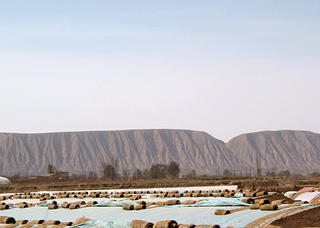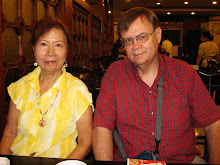Silk Road Adventure: Day 3 Lanzhou to Wuwei
 From the start I thought we should spend a full day in Lanzhou. It is the biggest city headed west. From what little I had read, I thought we could find things to do and things to see. The Bingling Grottoes, for example are a bunch of Buddhist caves that are situated on a cliff face, some 80km from Lanzhou. Bingling (Tibetian) means Ten Thousand Buddha. Besides the temple, the journey itself is supposed to be impressive, especially near the caves. Unfortunately, April is a no go on the river since there is not enough water to float a boat and there is no access by road.
From the start I thought we should spend a full day in Lanzhou. It is the biggest city headed west. From what little I had read, I thought we could find things to do and things to see. The Bingling Grottoes, for example are a bunch of Buddhist caves that are situated on a cliff face, some 80km from Lanzhou. Bingling (Tibetian) means Ten Thousand Buddha. Besides the temple, the journey itself is supposed to be impressive, especially near the caves. Unfortunately, April is a no go on the river since there is not enough water to float a boat and there is no access by road.  The Yellow River flows across Lanzhou The city has a 2,000-year history and is capital of Gansu Province. With a population of around three million people, it is one of the largest cities in the northeast, and also the most unpleasant because of the pollution that thickens the air and covers even the mountains on both sides of the river. Lanzhou was a significant fortress (for around 1,400 years) of the Hexi Corridor, the eastern and the most crucial stretch of the Silk Road. It enjoyed a long period of great prosperity until the Silk Road went away. The attractions in the city are not worth the visit. The city is modern and continues to expand upward and outward along the Yellow River. It, for me, was a city without a soul. A city build to be functional and that is about all.
The Yellow River flows across Lanzhou The city has a 2,000-year history and is capital of Gansu Province. With a population of around three million people, it is one of the largest cities in the northeast, and also the most unpleasant because of the pollution that thickens the air and covers even the mountains on both sides of the river. Lanzhou was a significant fortress (for around 1,400 years) of the Hexi Corridor, the eastern and the most crucial stretch of the Silk Road. It enjoyed a long period of great prosperity until the Silk Road went away. The attractions in the city are not worth the visit. The city is modern and continues to expand upward and outward along the Yellow River. It, for me, was a city without a soul. A city build to be functional and that is about all. We visited a the White Pagoda Hill Park which was full of families relaxing and walking around. There was little of interest to see except a Tibetian temple in which I was not allowed to take photos. I did find a music group with an old man playing the Er Hu. It was pretty good. The other big attraction, Five Springs Mountain Park was completely closed for renovations.
We visited a the White Pagoda Hill Park which was full of families relaxing and walking around. There was little of interest to see except a Tibetian temple in which I was not allowed to take photos. I did find a music group with an old man playing the Er Hu. It was pretty good. The other big attraction, Five Springs Mountain Park was completely closed for renovations.  The park was laid out on the side of a mountain and most of the buildings were being renovated and cleaned up. It was very commercial with all kinds of temple trinkets and other Buddhist things for sale.
The park was laid out on the side of a mountain and most of the buildings were being renovated and cleaned up. It was very commercial with all kinds of temple trinkets and other Buddhist things for sale.

This is a closeup of the above entrance door. The lion looks like a grape and was newly painted.

One thing to note, Lanzhou women are supposed to be some of China's most beautiful. We saw a fair number of very sophisticated ladies in downtown Lanzhou and there did appear to be a different look about them. I doubt though that they could seriously compete with the beauty found in Bangkok.
This (above) is an interesting door to one of the smaller buildings inside the temple compound.

We left Lanzhou and headed for Wuwei at around noon, having cancelled our second night in Lanzhou. The lady at our hotel could speak English quite well and she did not hesitate to practice with my wife and I. Her dream was to visit the United States.
We arrived in Wuwei, 273 Km from Lanzhou at around 4 in the afternoon, found a hotel and decided to make a quick trip to a local old Buddhist temple. According to my (not so trusty) Guide to the Silk Road, this place was within walking distance of the night market. The night market was just getting started, no problem in finding it so we asked directions to the Haizang Temple complex. "Within walking distance" means anything on the planet is within walking distance given enough time. It took us over a half hour to get to the temple. We had to travel though some very low rent slum areas of mud brick houses and the complex was in desperate need of repair. It was supposed to be very old and it looked it. The guide book said about 2.5 KM but trust me, it was closer to 10 or 12 kilometers and the road was unimproved (and I am being generous).

The complex is northwest of the city and has a landscaped Chinese garden and pond area in front of it. We parked the car inside this garden area. We spent about forty minutes walking around the area and taking pictures. No one is sure how old this place is except that it is "really old." Most scholars say it was build between the Song and Yuan dynasties but there are no official records of it. It was restored in 1965 and appears to need another restoration job. Hey, I liked it as it felt natural and was definitely not commercialized as in most of the old Chinese temples across China.



0 Comments:
Post a Comment
<< Home